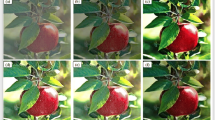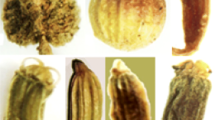Abstract
With an advancement in artificial intelligence (AI) applications, the use of smart imaging devices has been increased at a rapid rate. Recently, many researchers have utilized deep learning models such as convolutional neural networks (CNN) for image classification models. Compared to the traditional machine learning models, CNN does not require any kind of handcrafted features. It utilizes various filters to extract the potential features of images automatically. Inspired from this, in this paper, we have proposed a novel fruit classification model which utilizes the features of CNN, Long short Term Memory (LSTM) and Recurrent Neural Network (RNN) architectures. Type-II fuzzy enhancement is also used as pre-processing tool to enhance the images. Additionally, to tune the hyper-parameters of the proposed model, TLBO-MCET is also utilized. Extensive experiments are drawn by considering the existing and the proposed fruit classification models. Comparative analysis reveals that the proposed model outperforms the competitive fruit classification models.























Similar content being viewed by others
References
ANDRECUT M (1999) A statistical-fuzzy perceptron. Modern Physics Letters B 13(01):33–41
Dang C, Gao J, Wang Z, Chen F, Xiao Y (2015) Multi-step radiographic image enhancement conforming to weld defect segmentation. IET Image Process 9(11):943–950
Deng H, Sun X, Liu M, Ye C, Zhou X (2016) Image enhancement based on intuitionistic fuzzy sets theory. IET Image Process 10(10):701–709
Deng H, Sun X, Liu M, Ye C, Zhou X (2016) Image enhancement based on intuitionistic fuzzy sets theory. IET Image Process 10(10):701–709
Fang C, Mu D, Deng Z, Yan J (2017) Uncovering the fuzzy community structure accurately based on steepest descent projection. Modern Physics Letters B 31(27):1750249
Gill H S, Khehra B S, Singh A, Kaur L (2019) Teaching-learning-based optimization algorithm to minimize cross entropy for selecting multilevel threshold values. Egyptian Info J 20(1):11–25
Gill HS, Khehra BS (2020) Efficient image classification technique for weather degraded fruit images, IET Image Processing
Guo Y, Liu Y, Bakker EM, Guo Y, Lew MS (2018) cnn-rnn:a large-scale hierarchical image classification framework. Multi Tools App 77(8):10251–10271
Hautire N, Tarel JP, Aubert D, Dumont E (2011) Blind contrast enhancement assessment by gradient ratioing at visible edges. Image Anal Stereology 27(2):87–95
Horng M-H (2010) Multilevel minimum cross entropy threshold selection based on the honey bee mating optimization. Expert Syst Appl 37(6):4580–4592
Horng MH, Liou RJ (2011) Multilevel minimum cross entropy threshold selection based on the firefly algorithm. Expert Syst Appl 38(12):14805–14811
Kalyani R, Sathya PD, Sakthivel VP (2020) Trading strategies for image segmentation using multilevel thresholding aided with minimum cross entropy. Engineering Science and Technology, an International Journal
Li C, Yang Y, Xiao L, Li Y, Zhou Y, Zhao J (2016) A novel image enhancement method using fuzzy sure entropy. Neurocomputing 215:196–211
Liu W, Chen X, Chu X, Wu Y, Lv J (2016) Haze removal for a single inland waterway image using sky segmentation and dark channel prior. IET Image Process 10(12):996–1006
Mohanty B, Tripathy S (2016) A teaching learning based optimization technique for optimal location and size of dg in distribution network. J Electrical Sys Info Tech 3(1):33–44
Nagadurga T, Narasimham PVRL, Vakula VS (2020) Global maximum power point tracking of solar pv strings using the teaching learning based optimisation technique. Inter J Ambient Energy, pp 1–12
Naji AA, Lee SH, Chahl J (2017) Quality index evaluation of videos based on fuzzy interface system. IET Image Process 11(5):292–300
Nie F, Gao C, Guo Y, Gan M (2011) Two-dimensional minimum local cross-entropy thresholding based on co-occurrence matrix. Comp Electrical Eng 37(5):757–767
Rao RV, Patel V (2013) An improved teaching-learning-based optimization algorithm for solving unconstrained optimization problems. Scientia Iranica 20(3):710–720
Rao RV, Savsani VJ, Vakharia DP (2012) Teaching–learning-based optimization: an optimization method for continuous non-linear large scale problems. Inf Sci 183(1):1–15
Rao RV, Savsani VJ, Vakharia DP (2011) Teaching–learning-based optimization: a novel method for constrained mechanical design optimization problems. Comput Aided Des 43(3):303–315
Rasti P, Nasrollahi K, Orlova O, Tamberg G, Ozcinar C, Moeslund TB, Anbarjafari G (2017) A new low-complexity patch-based image super-resolution. IET Comput Vis 11(7):567–576
Russ JC (2016) The image processing handbook, CRC press, North Carolina State University, Materials Science and Engineering Department Raleigh, North Carolina, pp 1–85
Shi JP (2017) Prediction study on the degeneration of lithium-ion battery based on fuzzy inference system. Modern Physics Letters B 31 (19-21):1740083–1740091
Singh D, Kumar V (2017) Dehazing of remote sensing images using improved restoration model based dark channel prior. The Imaging Sci J 65 (5):282–292
Singh D, Kumar V (2018) Single image haze removal using integrated dark and bright channel prior. Modern Physics Letters B 32(04):1850051–1850058
Singh D, Kumar V (2017) Modified gain intervention filter based dehazing technique. J Modern Optics 64(20):2165–2178
Singh H, Khehra BS (2018) Visibility enhancement of color images using type-ii fuzzy membership function. Modern Physics Letters B 32(11):1850130
Tang K, Yuan X, Sun T, Yang J, Gao S (2011) An improved scheme for minimum cross entropy threshold selection based on genetic algorithm. Knowl-Based Syst 24(8):1131–1138
Tian Z, Jia L-M, Dong HH, Zhang Z-D, Ye Y-D (2015) Fuzzy peak hour for urban road traffic network. Modern Physics Letters B 29(15):1550074
Tripathi AK, Mukhopadhyay S (2012) Removal of fog from images: A review. IETE Tech Rev 29(2):148–156
Wang KL, Wang HB, Yu LX, Ma XY, Xue YS (2013) Teaching-learning-based optimization algorithm for dealing with real-parameter optimization problems. In: Applied mechanics and materials, vol 380, pp 1342–1345
YOO WJ, JI DH, WON SC (2010) Adaptive fuzzy synchronization of two different chaotic systems with stochastic unknown parameters. Modern Physics Letters B 24(10):979–994
Zhang J, Wu Q, Shen C, Zhang J, Lu J (2018) Multilabel image classification with regional latent semantic dependencies. IEEE Tran Multi 20(10):2801–2813
Zheng L, Shi H, Gu M (2017) Infrared traffic image enhancement algorithm based on dark channel prior and gamma correction. Modern Physics Letters B 31(19-21):1740044–1740050
Author information
Authors and Affiliations
Corresponding author
Additional information
Publisher’s note
Springer Nature remains neutral with regard to jurisdictional claims in published maps and institutional affiliations.
Rights and permissions
About this article
Cite this article
Gill, H.S., Khehra, B.S. Hybrid classifier model for fruit classification. Multimed Tools Appl 80, 27495–27530 (2021). https://doi.org/10.1007/s11042-021-10772-9
Received:
Revised:
Accepted:
Published:
Issue Date:
DOI: https://doi.org/10.1007/s11042-021-10772-9




